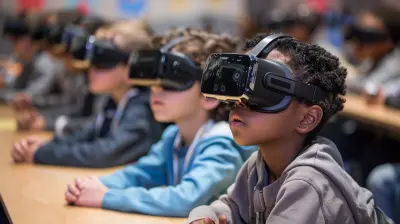Developing Leadership Skills Through Social-Emotional Learning
21 October 2025
Leadership isn’t just about directing people or making quick decisions—it’s also deeply rooted in empathy, communication, and self-awareness. And guess what? That’s where Social-Emotional Learning, or SEL, comes into play. Think of SEL as the foundation that great leaders build upon. It’s the glue that holds leadership qualities together. But how exactly does SEL help someone become a stronger leader? Let’s dive deep and unpack this.
What is Social-Emotional Learning (SEL)?
Before we talk leadership, let’s quickly understand what Social-Emotional Learning really means.In simple terms, SEL is the process of developing the self-awareness, self-control, and interpersonal skills that are vital for school, work, and life success. Imagine it like the emotional "toolbox" that helps students (and adults) manage emotions, build relationships, and make thoughtful decisions.
According to CASEL (Collaborative for Academic, Social, and Emotional Learning), SEL focuses on five core competencies:
1. Self-Awareness
2. Self-Management
3. Social Awareness
4. Relationship Skills
5. Responsible Decision-Making
Now, take a step back and think about every leader you’ve admired. Don’t these five traits show up somewhere in their personality?
Why Leadership and SEL Go Hand-in-Hand
We often think of leaders as people who stand in front, give speeches, and make big calls. But in truth, leadership starts from within. It’s about knowing who you are, understanding others, and building a vision that people want to follow. Sounds a lot like SEL, right?Here’s the deal—without emotional intelligence, leadership can fall flat. You might have the most brilliant idea in the world, but if you can’t connect with people or handle stress, your leadership will hit a wall.
Still not convinced? Let’s break it down further.
Core SEL Skills That Shape Strong Leaders
1. Self-Awareness: Know Thyself To Lead Others
Good leaders know their strengths, weaknesses, values, and emotions. That’s self-awareness in a nutshell.Let’s say a student is leading a group project. If they’re aware that public speaking makes them uneasy, they might ask a teammate to handle the presentation, while they focus on organizing ideas. That’s not weakness—that’s smart delegation rooted in awareness.
Without self-awareness, leaders can become reactive, defensive, or worse—completely unaware of how their actions affect others.
2. Self-Management: Keeping Cool Under Pressure
Leadership often means dealing with chaos. Deadlines, different opinions, surprises—it's all part of the package.Self-management is like having a calm captain at the wheel during a storm. Leaders with this skill don’t let their emotions dictate their actions. Instead, they pause, assess, and respond thoughtfully.
Whether it’s managing stress, controlling impulses, or staying motivated, self-management keeps leaders grounded and focused.
3. Social Awareness: Understanding Others' Shoes
A leader who doesn't understand their team is like a coach who never speaks to the players. Social awareness is the ability to pick up on other people’s emotions, needs, and perspectives.In school settings, this could mean recognizing when a classmate is struggling and offering help or adjusting your approach to include every group member’s voice.
In adult life, this leads to inclusive leadership—ones that value diversity, equity, and empathy.
4. Relationship Skills: Building Bridges, Not Walls
Leadership is 90% communication. Strong leaders form genuine connections, know how to resolve conflict, and work collaboratively.Students who learn relationship skills early are better teammates, listeners, and influencers. These are the folks others naturally look up to—and follow.
Think of it as building bridges instead of walls. With solid relationships, leadership becomes a shared journey, not a top-down system.
5. Responsible Decision-Making: Doing the Right Thing
Every decision a leader makes has a ripple effect. And great decisions come from critical thinking, ethics, and consideration of consequences—all parts of responsible decision-making.SEL helps students weigh options, consider others' feelings, and choose wisely—even when no one's watching. That’s integrity in action, and let’s be honest, the world could use more of that.
SEL in Education: A Breeding Ground for Future Leaders
Now here’s where it gets really interesting. Schools are no longer just about math equations and history dates. They're training grounds for future decision-makers, innovators, and change-builders.When SEL is integrated into classrooms, students not only perform better academically, but they’re more likely to lead clubs, organize events, and mentor peers.
And it goes beyond formal roles. Real leadership happens in everyday moments—like solving a dispute between friends or standing up for someone being bullied.
By encouraging SEL in schools, teachers and administrators plant seeds of leadership that grow long after graduation.
Real-Life Examples of SEL Empowering Student Leaders
Let’s put theory into action. Here are a few stories of SEL turning regular students into extraordinary leaders.Case #1: The Shy Student Turned Team Captain
Emma was always the quiet one in class. Not because she didn’t have ideas, but because she lacked confidence. Through SEL-focused programs, she learned to understand her anxiety and manage it. Over time, she started speaking up more and leading group discussions. Fast forward a year—Emma was elected as her school's team captain for the debate club.Case #2: The Hot-Head Who Learned Self-Regulation
Dev was brilliant but had a short fuse. He’d often get into arguments and struggled with teachers. After participating in SEL workshops, he learned techniques for emotional control and active listening. Today, he mentors younger students in conflict resolution.These are just small snapshots, but they show how powerful SEL can be in shaping leadership.
The Role of Teachers and Parents in Fostering SEL & Leadership
Kids don’t learn leadership in a vacuum. Teachers and parents play a critical role in modeling and nurturing these skills.What Can Teachers Do?
- Integrate SEL into lesson plans (journaling, group activities, empathy discussions)- Give students leadership roles in class (group leader, peer mentor, helper)
- Provide feedback not just on academics but also emotional growth
What About Parents?
- Encourage kids to express their feelings and talk about their day- Let children make choices and face the consequences
- Discuss leadership moments in movies, books, or daily experiences
It’s really about turning daily moments into teachable moments.
Long-Term Benefits: SEL Leaders in the Real World
Let’s fast forward—how does this actually pay off in the long run?Well, leaders shaped by SEL are:
- Better collaborators at work
- More resilient during tough times
- Trusted by their peers
- Ethical and fair in decision-making
- Adaptable, empathetic, and future-ready
They don't just thrive in careers—they thrive in relationships, communities, and society at large.
And let’s be real: In a world that’s constantly changing, isn't that the kind of leadership we all need?
The Future of Leadership Starts with SEL
It’s not a stretch to say that SEL is no longer optional—it’s essential. As the world demands more empathy-based, socially aware leadership, SEL equips students with the heart and brains to rise to the occasion.And the beauty of it? These skills can be taught, practiced, and improved over time. No one is born a leader. But with the right tools, anyone can become one.
So the next time you think about what makes a strong leader, remember—it’s not just charisma or credentials. It’s the emotional toolkit they carry. And SEL is the first step to filling that toolbox.
Final Thoughts
Leadership isn’t about being the loudest voice in the room. It’s about listening, understanding, and guiding others—not from above, but alongside. Social-Emotional Learning gives students the lens to see themselves and others clearly—and the tools to lead with clarity, compassion, and confidence.If we want better leaders for tomorrow, we need better learners today. And SEL is how we get there.
all images in this post were generated using AI tools
Category:
Social Emotional LearningAuthor:

Olivia Lewis
Discussion
rate this article
1 comments
Trixie Flores
Leadership begins within: harnessing social-emotional learning cultivates self-awareness and empathy, essential traits for inspiring others. Let's empower future leaders by prioritizing emotional intelligence in education!
October 21, 2025 at 2:47 AM

Olivia Lewis
Absolutely! Prioritizing emotional intelligence in education is crucial for nurturing self-aware and empathetic leaders. Thanks for emphasizing this vital aspect of leadership development!


